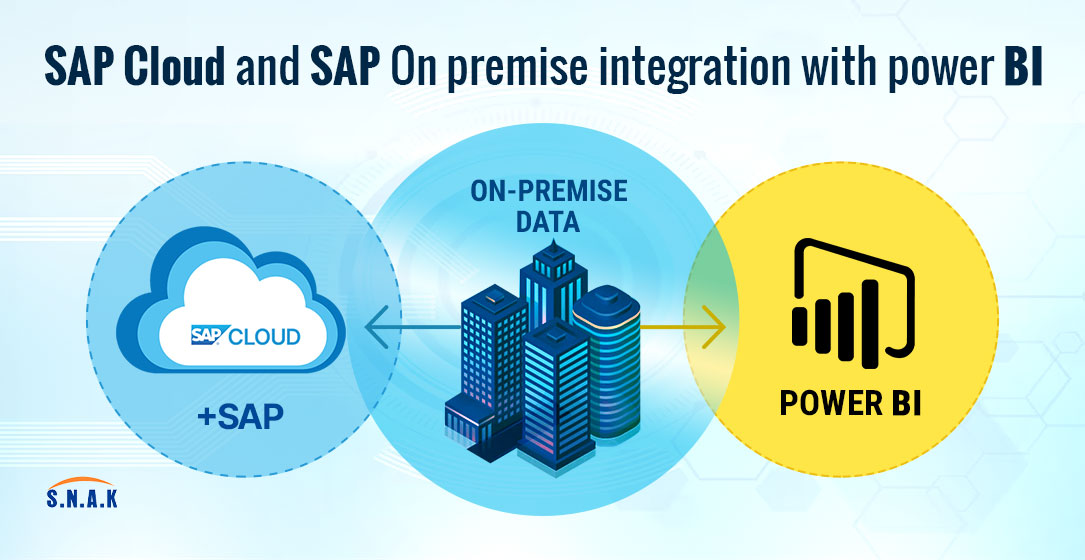April 28, 2024 | SNAK Consultancy
Share on :
SAP Cloud and SAP On-Premise Integration with Power BI: Bridging Data Worlds

In today's data-driven business landscape, organizations rely on seamless integration between their SAP systems and Power BI for comprehensive analytics and reporting. This integration not only enhances decision-making but also unlocks the full potential of enterprise data assets. Let's delve into how the convergence of SAP Cloud and SAP On-Premise with Power BI empowers businesses to harness actionable insights effectively.
1. Introduction to SAP and Power BI Integration:
The integration of SAP systems, whether in the cloud or on-premise, with Power BI brings together the operational and analytical aspects of business processes. It enables organizations to leverage their SAP data for interactive visualizations, advanced analytics, and real-time reporting within Power BI's intuitive interface.
2. SAP Cloud Integration with Power BI:
SAP Cloud solutions, such as SAP S/4HANA Cloud and SAP SuccessFactors, offer native connectors and APIs that seamlessly integrate with Power BI. This integration allows businesses to extract data from their cloud-based SAP applications and visualize it in Power BI dashboards and reports. Whether it's financial data, HR metrics, or sales performance, SAP Cloud integration enables real-time insights for informed decision-making.
3. Benefits of SAP Cloud and Power BI Integration:
1. Real-time Analytics: With direct connectivity between SAP Cloud and Power BI, organizations can access real-time data insights for timely decision-making.
2. Scalability: As businesses grow, SAP Cloud integration with Power BI scales effortlessly to accommodate increasing data volumes and analytics demands.
3. Enhanced Collaboration: Power BI's collaborative features enable teams to share insights across departments, fostering a data-driven culture across the organization.
4. SAP On-Premise Integration with Power BI:
For organizations with on-premise SAP systems like SAP ECC or SAP BW, integrating with Power BI offers similar benefits of real-time analytics and enhanced reporting capabilities. Using connectors like SAP HANA DirectQuery or SAP Business Warehouse (BW) Connector, businesses can extract data from their on-premise SAP systems and visualize it in Power BI.
5. Challenges and Considerations:
While integrating SAP systems with Power BI offers numerous benefits, organizations should consider certain challenges:
1. Data Security: Ensure that sensitive data extracted from SAP systems is handled securely within Power BI.
2. Data Governance: Implement robust data governance policies to maintain data integrity and compliance.
3. Performance Optimization: Optimize query performance and data refresh schedules to ensure efficient reporting.
6. Best Practices for Integration:
1. Utilize SAP-certified connectors and APIs for seamless integration between SAP systems and Power BI.
2. Leverage data modeling techniques within Power BI to create meaningful relationships and hierarchies for insightful analysis.
3. Implement role-based access control (RBAC) to restrict data access and ensure compliance with regulatory requirements.
7. Future Trends and Innovations:
The convergence of SAP Cloud, SAP On-Premise, and Power BI is poised for further innovation:
1. AI and ML Integration: Incorporating AI and ML capabilities within Power BI enhances predictive analytics and enables intelligent insights.
2. IoT Integration: Integrating IoT data from SAP Leonardo with Power BI enables real-time monitoring and analytics for connected devices.
3. Advanced Visualization: Continued advancements in Power BI's visualization capabilities enable richer, more interactive dashboards and reports.
Questionnaire
Ques.1 How does SAP Cloud integration with Power BI enhance business analytics?
Ans SAP Cloud integration with Power BI enables real-time access to cloud-based data, facilitating timely insights for decision-making.
Ques. 2 What benefits does SAP On-Premise integration with Power BI offer?
Ans. Integrating on-premise SAP systems with Power BI provides enhanced reporting capabilities and access to historical data for comprehensive analytics.
Ques.3 What are some key considerations when integrating SAP systems with Power BI?
Ans. Organizations must prioritize data security, governance, and performance optimization to ensure successful integration and compliance.
Ques.4 How can businesses optimize their integration for maximum efficiency?
Ans. Utilizing SAP-certified connectors, implementing robust data modeling techniques, and enforcing role-based access control is essential for optimized integration.
Ques.5 What future trends can we expect in SAP and Power BI integration?
Ans. The integration is poised for advancements in AI and ML integration, IoT data integration, and advanced visualization capabilities to drive further innovation in business analytics.
Conclusion :
Integrating SAP Cloud and SAP On-Premise systems with Power BI empowers organizations to unlock the full potential of their data assets. By leveraging real-time analytics, scalability, and enhanced reporting capabilities, businesses can make informed decisions and drive digital transformation initiatives effectively in today's competitive landscape.